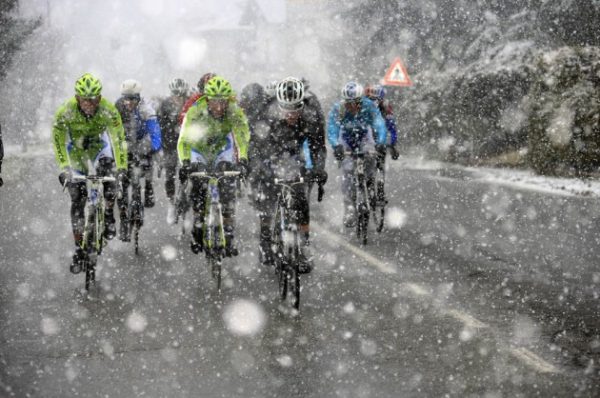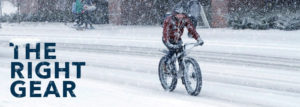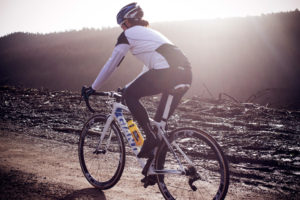Pro cyclists know that the coming of winter is not the end of the cycling season — it’s the beginning. If you leave your bike in the garage all winter, say goodbye to hard-earned summer muscle. The riding you do between November and March preserves and builds both your fitness and mental toughness.
Some argue that stationary bikes keep you in shape, and that’s probably true, but they’re boring. Even if you manage to knock out a few sessions at first, it’s likely you’ll abandon it after the first few weeks anyway. Outdoor cycling is more fun (check out fat biking), and you’ll maintain your fitness both mentally and physically if you ride outside during cold weather.

Reasons to Cycle in Cold Weather
Reasons to cycle during cold winter months aren’t isolated to fitness. Cycling outside includes benefits that come from battling the elements. Cold weather cycling builds skills, toughens you up and offers peace and solitude, just to mention a few.
Skill Builder
Navigating on ice, snow or water-soaked pavement requires more skill. High-pressure road bike tires have little or no tread — they’re not designed for slick conditions. Even the slightest wobble on wet pavement can cause you to go down. Skills you gain through the winter transfer to your bike handling skills during summer months.
Ice and Snow
Riding road bikes on wet pavement is one thing, but leave your road bike in the garage if roads are snow covered or icy. Riding on snow and ice is just too dicey on a road bike. Get out your mountain bike. If you don’t have a mountain bike, get one. Mountain bikes are tougher and more stable than delicate road bikes, and can take more punishment. Riding on snow and ice can also be risky on a mountain bike, but the difference between a fat tire with knobs, and the slick minimalist road bike tire is infinitesimal. Mountain bike tires grip and hold where road bike tires spin and fail. You haven’t lived until you’ve left bicycle tracks on fresh snow with a mountain bike.
It’s Not as Bad as it Looks (with the right gear)
Sitting in the warm house with coffee or hot chocolate, looking out the window is a motivation killer. But the weather is never as bad as it looks from your easy chair. Most pros regard anything above 50 degrees as warm weather riding conditions. With all the cold weather riding gear available, there’s no excuse to not ride outside, keeping warm is easy, and not something you should be afraid of.
Sitting and thinking about what you might need to stay warm outside is another motivation killer. It takes time to find everything and put it on, get your bike ready and so-on. Place all your gear in a single location. Helmet, gloves, shoes, undergear and outergear. If you assemble everything, and keep it ready in one spot, the task is simple. You don’t have to go to the closet, find one thing, go to a different spot, find something else. It might seem insignificant, but it matters. Once you go through the procedure a few time, you’ll understand. And don’t worry about wearing the same outergear multiple times. If it’s not soaked with sweat, it’s good to go. Use your own personal hygiene routine as a guide, cyclists are all different. Some sweat profusely, others don’t.

A Look at Gear
It’s typical to overdress for a cold-weather ride. It feels good the first few miles, but once your core heats up, you’ll likely be too hot. You’re probably sick of hearing it, but layering is the key, light layers that you can vent or remove. In most instances a light, long-sleeved thermal, followed by a long-sleeved cycling jersey with a hood — you might have to look around for one of these — but they’re worth their weight in gold. Top the jersey off with a nylon or semi-waterproof windbreaker with a turtle neck — this too may be hard to find, but once you’ve went turtleneck in cold weather, you’ll never go back.
Skin Exposure
Riding gear should seal around the neck and sleeves. Before you buy it, make sure it’s long enough in the sleeve, so that when you get down in the drops, it doesn’t pull up and expose your wrists. Nothing is more annoying than a patch of open skin between your gloves and windbreaker.
Ears, Fingers and Toes
It’s relatively easy to keep your torso warm, but if your hands, fingers or feet get cold, you’ll want to abandon your ride. Almost any glove will do, but test fit and check out some of the best to make sure you can still brake and shift accurately. Ears are another issue. The hooded jersey is the answer. Never leave your ears without some type of cover. Stocking caps are doable, but they often prevent the proper fit of your helmet. The thin fabric of the hooded jersey fits nicely under your helmet.
Doing the miles in rain, cold, wind or snow toughens you up. You’ll experience colder tolerance levels each time you ride in weather below 50-degrees. If you need inspiration, cyclists who compete in the Iditarod race offer it. Billed as the Last Greatest Race on Earth, the Iditarod is a 1,000 miles over the rugged Alaska mountain range in temperatures exceeding minus 20-degrees Fahrenheit. Cyclists are out there 20 days or more, in the snow and ice, all by themselves. Just thinking about them should get you off the couch. The Iditarod isn’t for everybody, but it’s a perfect example of human endurance, and the fact that cold weather won’t kill you if you’re prepared for it.
Warm and cozy clothing, a deserted stretch of highway, the stillness of winter (especially if it’s snowing) add up to peace and quiet that you’ve never experienced before, it can do as much for your head as your heart. Winter cycling is a sport that the majority of weekend cyclists might not consider, but if you’re a true cyclist, you won’t let cold weather keep you from enjoying your sport.
